国际商业环境
国际商务环境与市场分析

国际商务环境与市场分析企业的国际化已经成为一个必然趋势,这不仅与科技的不断发展有关,也与国际贸易的开放化程度以及全球化的加速有关。
在这样一个国际化的时代背景下,企业进入海外市场已经成为必然选择,但是如何分析国际商务环境以及开展市场分析,这是企业进行海外市场拓展的重要前提。
一、国际商务环境分析国际商务环境的分析可以从外部环境与内部环境两个方面来考虑。
外部环境的分析包括经济环境、政治环境、文化环境以及法律环境等方面。
其中,经济环境是最关键的因素,它既是企业海外进军的动力源泉,也是企业所面临的最大挑战。
在经济环境的分析中,主要考虑国家的宏观经济形势、市场供需关系以及行业竞争情况等方面,这些因素将直接影响到企业在当地市场的发展与竞争。
政治环境的因素包括政府政策、政治稳定与国际关系等方面,这些因素将影响企业在当地市场的发展以及企业与其他主体之间的合作和交流。
文化环境文化差异也是一个影响因素,企业应该将所入的目标市场不同文化差异考虑在内,以便更好地与当地市场的消费者、合作伙伴以及其他利益相关者进行沟通与交流。
法律环境可以说是国际商务中最复杂的环境之一,考虑到各国法律体系的不同以及不同的商业规则,企业应该进行深入的了解和研究,以便更好地应对当地法律环境的挑战与机遇。
内部环境的分析涉及到企业自身的资源和竞争力等方面。
企业需要进行核心竞争力分析以及SWOT分析,以便更好地把握自身的优劣势,为进入海外市场做好准备。
二、市场分析的要素市场分析是企业进行海外拓展的重要前提。
市场分析主要包括市场规模、市场细分、市场竞争、市场需求以及市场趋势等因素。
市场规模是指目标市场的总体规模,包括宏观环境的总体数据以及竞争对手的市场份额等方面。
市场细分则是针对目标市场进行更加具体的分析,包括目标消费者的商业分类、消费者行为特征以及市场分布情况。
市场竞争是分析当地市场的市场竞争对手,考虑竞争对手的市场份额、商业策略和产品优劣势等方面。
市场需求是分析目标市场的消费者需求和消费者心理特征等,帮助企业更好地了解当地市场的特点和对于产品的热度。
2.国际商务环境
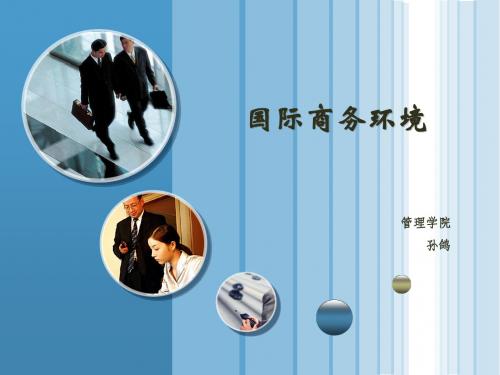
社会文化
中观 环境
技术环境
法律环境
政治环境---1.政治体制
“沉默的合伙人,具有无形控制力的合伙人”--
--政治环境的变化时国际影响最大破坏性最强的 变化
政治体制:一国的政府体制,两个尺度大程度上是民主或者极权的。这两者相互关 联,一般强调集体主义的政治体制比较级权化, 而把个人主义至于很高地位的政治体制则比较 民主。
前夕阶段、起飞阶段、趋向成熟阶段、高 度消费阶段
不同经济发展水平下,市场需求能力、消
费偏好、预算约束和产业特征不同,对国 际企业的吸引力和影响力也不同
GNI和PPP
GNI人均国民总收入,PPP购买力平价
国家 巴西 中国 德国 印度 日本 尼日利亚 波兰 俄罗斯 瑞士 2004年人均GNI (美元) 3000 1500 30690 620 37050 430 6100 3400 49600 2004年人均PPP (美元) 7935 5885 28168 3116 29814 966 12723 9683 35661 1994-2004GDP增长率 (%) 2.7 9.5 1.5 6.3 1.2 3.5 4.5 1.5 1.3 2004年经济规模 (10亿美元) 600 1930 2740 691 4620 72 242 581 358
知识产权保护
计算机软件、屏幕游戏、音乐曲谱或新药的化学方程式
等智力活动产品的权力。通过专利、版权、商标形式拥 有知识财产的所有权是可能的
知识产权法奖励原创者,则发明和创造性的工作就得到
激励
《保护知识产权巴黎公约》截止2006年已有169个国家
签署
WTO也将更严厉的监督知识产权保护,专利保护期延
罗马法时,是以法典为依据的。
企业跨国经营理论之国际商业环境分析

跨国公司
• 跨国公司在全球经济中地位上升
• 90年跨国公司的国外总产值超过了国际贸易 • 很多跨国公司的国外收益超过国内收益 • 如埃克森,吉列,波士顿银行,可口可乐,华旗银
行,IBM,HP,P&G,J.P 摩根等
• 跨国公司带来了世界经济组织的变化
• 从由价格为导向的纯商业买卖发展为开放的 世界经济体系
国际化动力
• 我们用四组因素来分析国家或行业国际化的动力
市场国际化动力 成本国际化动力 政府国际化动力 竞争国际化动力
市场国际化动力
• 相似的消费者需求 • 可移植的营销策略 • 全球或区域性的顾客 • 全球或区域性的渠道
相似的消费者需求(I)
• 区域内甚至世界范围内的其他国家对该 产品/服务有相似需求的程度
WTO 的整套协议中包括
• 与贸易有关的投资协定(Trade Related aspects of Investment Measures,TRIMS)
• 针对贸易补贴的协定(Subsidies & Countervailing Measures)
• 针对服务的协定(GATS) • 与贸易有关的知识产权协定(Trade Related
全球或区域性的顾客
• 作为全球或区域顾客的公司有各区域的 总部或在世界上有重要的业务
• 如咨询公司、物流配送公司等。 • 如通用汽车在国际化的同时,带动了一批
其零部件供应商的国际化.
全球或区域的分销渠道
• 产品在全球或区域有相似的分销渠道
成本国际化动力
• 全球或区域的规模经济
• 良好的资源 • 良好的物流体系 • 良好的基础设施 • 较低的国家成本 • 技术的作用
如何适应全球一体化的商业环境
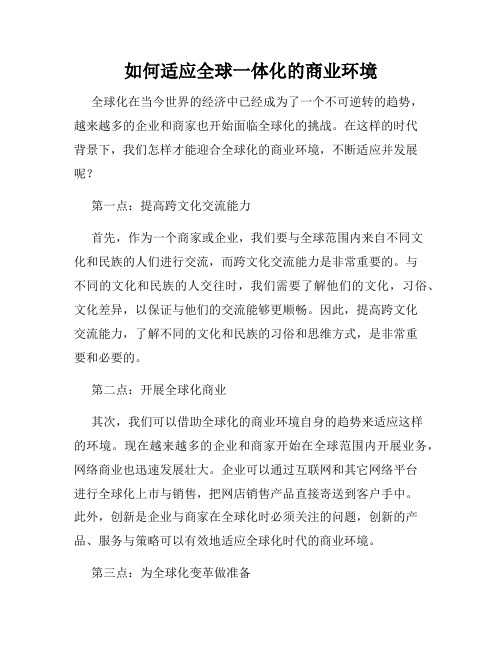
如何适应全球一体化的商业环境全球化在当今世界的经济中已经成为了一个不可逆转的趋势,越来越多的企业和商家也开始面临全球化的挑战。
在这样的时代背景下,我们怎样才能迎合全球化的商业环境,不断适应并发展呢?第一点:提高跨文化交流能力首先,作为一个商家或企业,我们要与全球范围内来自不同文化和民族的人们进行交流,而跨文化交流能力是非常重要的。
与不同的文化和民族的人交往时,我们需要了解他们的文化,习俗、文化差异,以保证与他们的交流能够更顺畅。
因此,提高跨文化交流能力,了解不同的文化和民族的习俗和思维方式,是非常重要和必要的。
第二点:开展全球化商业其次,我们可以借助全球化的商业环境自身的趋势来适应这样的环境。
现在越来越多的企业和商家开始在全球范围内开展业务,网络商业也迅速发展壮大。
企业可以通过互联网和其它网络平台进行全球化上市与销售,把网店销售产品直接寄送到客户手中。
此外,创新是企业与商家在全球化时必须关注的问题,创新的产品、服务与策略可以有效地适应全球化时代的商业环境。
第三点:为全球化变革做准备除此之外,我们也应该为全球化时代的变革及其带来的新机遇做好准备。
如全球市场的开拓,新技术和新业态的应用,以及全球化时代所带来的新机遇等。
同时,我们也应该密切关注全球经济开始转型的迹象,寻求与时俱进的商业发展机会。
第四点:积极参与国际组织最后,积极参与国际组织是一个很好的适应全球化商业环境的途径。
加入国际商务组织和协会,不仅可以拓展商务人际网络,了解全球商业环境,还可以参与制定和影响国际商业政策的制定,使自己和企业的发展能够更好地适应全球化商业环境。
在全球化的商业背景下,只有不断适应和发展,才能够在激烈的商业竞争中立于不败之地。
提高跨文化交流能力,发展全球化商业,以及积极参与国际组织,都是适应全球化商业环境的有效途径,而为全球化变革做好准备也是必不可少的一步。
全球商业环境及其影响因素的分析研究

全球商业环境及其影响因素的分析研究近年来,全球经济进入了一个快速发展的阶段,国际贸易和跨国公司不断涌现,全球商业环境也因此发生了巨大变化。
在这种多变的商业环境下,企业如何应对国际竞争,如何了解和应对全球商业环境的影响因素,成为了摆在企业面前最为重要的问题之一。
一、全球商业环境的背景随着全球化进程的加快,全球商业环境发生了深刻的变化。
全球范围内的科技革命和信息革命为世界经济带来了前所未有的发展机遇。
尤其是自1990年代以来,全球化已经成为了全球最为关注的话题之一,跨国公司不断涌现,全球市场已经成为了跨国公司的主要发展目标。
二、全球商业环境的特点全球商业环境具有多样性和复杂性两个特点。
首先,全球的商业环境具有很强的多样性。
不同国家的文化、法律、政治、经济等因素均会对商业环境产生影响。
其次,全球商业环境也具有很强的复杂性。
不同国家之间经济和政治上的联系十分紧密,而且这种联系也在不断的变化之中,因此企业需要不断地跟进和适应这种变化。
三、全球商业环境的影响因素1. 国际市场国际市场是企业获得利润的重要来源。
全球市场范围的不断扩大,使得企业可以更加灵活地进行生产和销售,同时也使得企业需要重视市场环境和竞争态势。
2. 贸易政策贸易政策对企业在国际贸易中的表现产生重要影响。
不同国家的贸易政策和贸易协定会对企业的跨国商业活动产生不同的影响,并且不断变化的贸易政策也给企业发展带来了不确定性。
3. 技术进步对于企业发展来说,技术进步是至关重要的。
全球范围内的技术创新和信息传播,无疑对企业在全球商业环境中的生产和管理产生了重要的影响。
4. 经济周期经济周期的波动对企业的生产和销售都会产生重要影响。
在全球范围内,经济周期的波动也会导致国际市场的竞争态势发生变化,因此企业需要在不同的经济周期中作出不同的战略调整。
5. 政治因素政治因素对企业的商业行为也产生着不可忽视的影响。
全球范围内不同国家之间的政治联系和政治力量的变化,无疑也会对企业的跨国行为和竞争态势产生重要影响。
国际商业环境对企业营销的影响
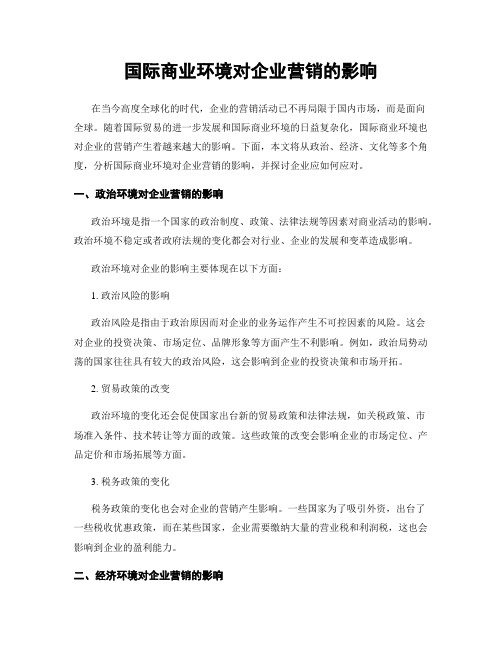
国际商业环境对企业营销的影响在当今高度全球化的时代,企业的营销活动已不再局限于国内市场,而是面向全球。
随着国际贸易的进一步发展和国际商业环境的日益复杂化,国际商业环境也对企业的营销产生着越来越大的影响。
下面,本文将从政治、经济、文化等多个角度,分析国际商业环境对企业营销的影响,并探讨企业应如何应对。
一、政治环境对企业营销的影响政治环境是指一个国家的政治制度、政策、法律法规等因素对商业活动的影响。
政治环境不稳定或者政府法规的变化都会对行业、企业的发展和变革造成影响。
政治环境对企业的影响主要体现在以下方面:1. 政治风险的影响政治风险是指由于政治原因而对企业的业务运作产生不可控因素的风险。
这会对企业的投资决策、市场定位、品牌形象等方面产生不利影响。
例如,政治局势动荡的国家往往具有较大的政治风险,这会影响到企业的投资决策和市场开拓。
2. 贸易政策的改变政治环境的变化还会促使国家出台新的贸易政策和法律法规,如关税政策、市场准入条件、技术转让等方面的政策。
这些政策的改变会影响企业的市场定位、产品定价和市场拓展等方面。
3. 税务政策的变化税务政策的变化也会对企业的营销产生影响。
一些国家为了吸引外资,出台了一些税收优惠政策,而在某些国家,企业需要缴纳大量的营业税和利润税,这也会影响到企业的盈利能力。
二、经济环境对企业营销的影响经济环境是指一个国家的经济制度、文化氛围、产业结构、营商环境等因素对商业活动的影响。
经济环境对企业的影响主要体现在以下几点:1. 消费能力的影响经济环境直接影响到消费者的消费能力,从而影响到企业的市场销售情况。
在经济萎靡的时期,消费者的消费能力下降,企业的销售收入也相应地下降。
2. 市场需求的变化随着经济环境的改变,消费者对产品和服务的需求也会发生变化。
企业需要适应市场的变化,及时进行产品和服务的升级迭代,以更好地满足消费者的需求。
3. 供应链的变化随着经济环境的变化,供应链也会发生变化。
从企业角度看世界社会和商业环境分析

从企业角度看世界社会和商业环境分析随着全球化的发展,企业在市场竞争中所面临的社会和商业环境也越来越复杂和多变。
从企业角度来看,深入理解世界社会和商业环境的现状和趋势,对企业可持续发展至关重要。
本文将从以下几个方面进行分析。
一、社会环境分析随着人口不断增长和城市化加速,人口老龄化、教育水平提高、生活方式多样化、信息透明度增加等一系列社会变化正在发生,这些变化将对企业的经营产生很大影响。
首先,人口老龄化是全球范围内的一个共性问题,老年人口对健康、生活质量的需求不断增加,这将导致老年人市场口味、需求的多元化趋势加剧。
企业应当关注老年人群体的消费特征,根据不同的需求和偏好设计开发产品,深入挖掘这个庞大的潜在市场。
其次,教育程度的提高也带来很多机遇和挑战。
高受教育人口的数量逐年增加,更加看重品质和使用体验,更加注重消费品牌的社会责任和环保意识。
因此,维护良好的企业社会形象和品牌形象,实现可持续经营至关重要。
同时,信息透明度的提高和普及也让消费者更加理性化和透明化。
消费者在购买商品前会自行比价、查询评价等,企业的产品质量、服务水平以及企业社会责任都必须得到严格把关,方能符合消费者期望。
最后,生活方式的多样化和快节奏的现代生活也越来越受到关注。
由于工作和压力等因素,越来越多的人选择快餐和外卖代替传统的家庭食物,这使得快餐市场和互联网餐饮行业不断壮大。
对于企业来讲,在不断满足消费者快节奏、便捷的同时,也可探索更多健康和环保的生活方式,如绿色、有机农业等。
二、商业环境分析随着全球城市化、科技水平的不断提高和消费者的需求多元化,商业环境也在不断变迁,如何应对市场的变化,不断创新和适应消费者需求,是企业在未来的竞争中所必须重视的。
首先,在全球化的背景下,国际市场的竞争尤为激烈。
企业需要不断扩大自己的全球化视野,抓住国际化机会,充分了解目标市场需求和文化背景,制定符合当地文化特色的市场策略和营销策略,以增强企业自身的竞争力。
国际商务谈判中如何处理复杂的商业环境
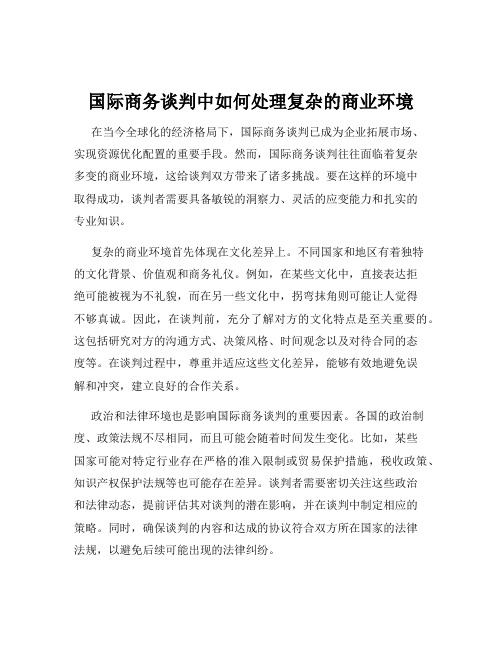
国际商务谈判中如何处理复杂的商业环境在当今全球化的经济格局下,国际商务谈判已成为企业拓展市场、实现资源优化配置的重要手段。
然而,国际商务谈判往往面临着复杂多变的商业环境,这给谈判双方带来了诸多挑战。
要在这样的环境中取得成功,谈判者需要具备敏锐的洞察力、灵活的应变能力和扎实的专业知识。
复杂的商业环境首先体现在文化差异上。
不同国家和地区有着独特的文化背景、价值观和商务礼仪。
例如,在某些文化中,直接表达拒绝可能被视为不礼貌,而在另一些文化中,拐弯抹角则可能让人觉得不够真诚。
因此,在谈判前,充分了解对方的文化特点是至关重要的。
这包括研究对方的沟通方式、决策风格、时间观念以及对待合同的态度等。
在谈判过程中,尊重并适应这些文化差异,能够有效地避免误解和冲突,建立良好的合作关系。
政治和法律环境也是影响国际商务谈判的重要因素。
各国的政治制度、政策法规不尽相同,而且可能会随着时间发生变化。
比如,某些国家可能对特定行业存在严格的准入限制或贸易保护措施,税收政策、知识产权保护法规等也可能存在差异。
谈判者需要密切关注这些政治和法律动态,提前评估其对谈判的潜在影响,并在谈判中制定相应的策略。
同时,确保谈判的内容和达成的协议符合双方所在国家的法律法规,以避免后续可能出现的法律纠纷。
经济环境的复杂性同样不容忽视。
汇率波动、通货膨胀、市场供求关系的变化等都可能对谈判结果产生重大影响。
以汇率波动为例,如果在谈判期间汇率发生大幅变动,可能会导致原本预期的利润大幅缩水。
因此,谈判者需要对经济形势进行准确的分析和预测,在合同中合理设定价格调整机制、支付方式和风险分担条款,以降低经济环境变化带来的风险。
市场竞争环境也是国际商务谈判中需要考虑的一个关键因素。
在一个竞争激烈的市场中,供应商众多,买方往往具有更多的选择和议价能力。
反之,在垄断或寡头垄断的市场中,卖方则可能占据更有利的地位。
了解市场竞争格局,掌握竞争对手的优势和劣势,能够帮助谈判者更好地制定谈判策略,确定自己的底线和目标。
国际商务环境与趋势分析

国际商务环境与趋势分析近年来,全球经济的发展速度越来越快,各国之间的经济联系日益紧密。
国际商务已经成为一个不可忽略的重要部分。
随着信息技术、交通技术和通讯技术的快速发展,国际商务的环境和趋势也在不断变化。
本文将从全球经济、技术革新、贸易政策等方面,分析当前国际商务的环境和趋势。
一、全球经济形势当前全球经济形势依然严峻,全球化进程的放缓,多年的经济周期逐渐结束,一些国家的经济增长率逐渐放缓,如中美贸易摩擦等一系列贸易保护主义措施的出现,都成为全球贸易带来了较大的不确定性。
这些变化都在一定程度上影响了国际商务的发展,尤其是出口型企业。
二、技术革新信息技术、交通技术和通讯技术革新的加速,使得国际商务的交流更为便捷和快速,给国际商务带来了新的发展机遇。
例如,通过互联网,企业可以深入海外市场,展示自己的产品和服务,开发新的客户群体。
同时,人工智能、区块链等新技术也为国际商务提供了更多的创新应用。
与此同时,新技术的出现也带来了新的挑战,如网络安全威胁等。
因此,企业必须积极应对新技术带来的机遇和挑战。
三、贸易政策随着国际贸易逐渐转型,各国的贸易政策也开始发生变化,一些国家加大了贸易保护措施,出现了征收关税等政策,这些政策对国际商务的发展产生了不良影响。
在这种情况下,企业应该多样化出口市场,并加强企业的整体竞争力,减少对单一市场的依赖。
四、人才和教育人才和教育是企业发展的关键因素之一。
随着国际商务的不断发展,各种新兴模式和新技术正不断涌现。
因此,企业需要不断培养人才,吸纳市场竞争和技术前沿方面的人才,使企业在市场上具有更强的竞争力。
同时,各学校和研究机构也需要面对这些新挑战,为市场提供更加高端、精准、专业的人才。
五、可持续发展可持续性的发展是人类社会的大趋势。
国际商务的发展也应该服从可持续性的要求。
企业需要从产品和生产过程的角度来考虑各种可持续性问题,加强环境保护和社会责任,不仅可以获得社会的认可和可持续发展,还能为企业带来更好的发展机遇。
第2讲 国际商务环境(2011)

4、事业成功与生活质量 这个维度指的是人们强调自信、竞争、 物质主义(事业成功导向)还是强调人际关 系和他人利益(生活质量导向)的程度。 提到的墨西哥工人不愿加班的例子表明, 墨西哥文化更注重的是生活质量,而美国 文化更注重的是事业成功。
5、长期一短期导向 这个维度是指一个文化对传统的重视程 度。 霍夫斯坦特发现这4个亚洲国家和地区(香 港,台湾,韩国,新加坡)有一个共同的特点, 那就是对传统的重视,而且有凡事都想到未 来的倾向,而非只想当前,做一锤子买卖。 这种长期导向与国家经济发展速度之间的相 关系数达0.7之高
2.民族主义 民族主义(nationalism)是一种强烈的民族 自豪感和团结心,而这种自豪感可能带有 对外国企业的偏见。
民族主义的主要表现多种多样,如: 号召人民“只买国货” 主张关税及其他贸易壁垒限制进口 限制外国投资(没收、限制外国投资的政 策,国有化征用等)
二、政治风险及其类型
第三节 法律环境和商业伦理
开篇案例:“朗讯门”事件 全球著名的电信设备制造商阿尔卡特一 朗讯公司2007年12月表示,已就其涉嫌向中 国官员贿赂而违反美国反海外腐败渤一事与 美国司法部达成调解协议,阿尔卡特一朗讯 方面将向美国司法部和美国证券交易委员会 分别支付100-150万美元罚金。
美国证监会指控,从2000-一2003年, 朗讯邀请约1 000名中国国有电信公司官员 赴美国或其他地方旅行,为此花费超过1 000万美元。许多旅行中,中国企业官员们 在美国只花很少甚至不花时间去参观朗讯工 厂。相反,他们在各个旅游点如夏威夷、拉 斯维加斯、大峡谷、尼亚加拉大瀑布、迪斯 尼世界、环球影城和纽约游玩。
二、霍夫斯坦特的文化维度理论
文化维度理论是跨文化理论中至今最具 影响力的一个理论,由荷兰管理学者霍夫斯坦 特(Hofstede,1980,1991)提出。
国际商务的宏观环境分析

国际商务的宏观环境分析国际商务的宏观环境是影响企业在全球市场上运作的宏观因素。
这些因素涵盖了政治、经济、法律、文化等多个方面,需要企业对其进行系统性的分析,以做出正确的商业决策。
在分析宏观环境时,企业需要关注以下几个方面。
政治因素政治是宏观环境中最重要的因素之一,政治环境的稳定与否,将直接影响企业的经营和发展。
政治环境中包括政府制度、政策等因素,包括贸易政策、税收政策、外汇政策和投资政策等。
企业应该关注本国政府对国际贸易的态度和政策,以及其他国家与地区对贸易的限制和保护措施。
经济因素经济环境是企业决策的重要因素之一,在全球经济中,货币汇率、物价、经济增长率、不稳定性、通货膨胀率等因素会影响企业的经济活动。
企业应该密切关注全球经济的发展动向、通货膨胀率、劳动力成本,以及国际货币政策、金融政策等。
法律因素法律环境也是企业关注的重点,它包括国际贸易法、知识产权法和相关投资法规等。
企业需要了解并遵守相关法律法规,以规避在跨国经营过程中可能遇到的法律风险,包括合同纠纷、知识产权冲突或拐卖等。
文化因素文化环境是企业在全球市场上运作的重要因素,由于世界各国的文化差异,企业应该针对不同市场对文化差异进行深入分析,包括语言、宗教、社交礼仪、文化习俗、传统价值观等,以便制定适当的营销策略。
技术因素技术环境是企业在全球市场上运作的另一个重要因素。
随着信息化时代的到来,互联网的普及和快速推广越来越受到重视。
先进的互联网技术使得跨国企业的管理和交流变得更加便捷和高效。
因此,企业应该把握技术创新的机会,及时更新和调整企业信息化管理模式,以保持企业的竞争力。
总之,对于国际商务企业,准确地把握宏观环境的趋势和动态,对于企业的发展至关重要,企业应该对关键的宏观环境因素进行深入的调研和分析,从而制定符合自身特点和目标的商业策略。
美国国际商务制度环境分析

跨文化培训
美国企业重视跨文化培训 ,提高员工对不同文化背 景的认知和理解,增强跨 文化沟通能力。
本地化战略
美国企业在国际商务中采 用本地化战略,适应不同 国家和地区的文化和社会 环境,提高市场竞争力。
国际合作与交流
美国积极开展国际合作与 交流,与其他国家建立经 贸关系,促进国际商务的 发展。
THANKS
美国国际贸易政策和制度
关税政策
贸易救济措施
美国通过征收关税来保护国内产业和 就业,关税是国际贸易政策的重要手 段之一。
当国内产业受到进口商品的损害时, 美国可以采取一系列贸易救济措施, 如反倾销、反补贴和保障措施等。
贸易协定
美国与其他国家签订了一系列贸易协 定,如北美自由贸易协定、美欧自由 贸易协定等,以促进贸易自由化和便 利化。
感谢观看
美国国际贸易的主要挑战和改革方向
贸易保护主义
随着全球贸易保护主义的抬头, 美国面临着越来越多的贸易壁垒
和报复措施。
贸易不平衡
美国与其他国家的贸易不平衡问 题依然存在,这可能导致贸易摩
擦和汇率波动。
改革方向
美国政府正在推动一系列贸易改 革措施,包括加强贸易谈判、促 进贸易自由化和便利化、加强知 识产权保护等,以促进美国经济
美国文化和社会环境的特点和挑战
多元文化
美国是一个多元文化的国家,拥 有来自世界各地的移民,这种多 元文化环境为国际商务带来了挑
战和机遇。
法律体系
美国的法律体系健全,法律法规严 格,对国际商务活动产生一定的影 响。
经济竞争
美国经济实力强大,市场竞争激烈 ,对国际商务合作和竞争带来一定 压力。
美国在国际商务中如何应对文化和社会差异
美国国际商务的主要领域和特点
国际商务环境现状与趋势

国际商务环境现状与趋势在全球经济快速发展的大环境下,我国国际贸易的发展历程必然是机遇与挑战并存的。
随着我国在国际贸易领域中的地位越来越重要,综合国力越来越强,必然会给我国的国际贸易带来更多合作伙伴。
但我国的产业结构和产业技术等方面发展较为滞后,严重制约了我国国际贸易的发展。
因此,必须要采取有效措施,积极探索,促进我国国际贸易的发展一、我国国际贸易发展现状目前,我国已成为世界范围内最重要的产品加工基地,现代化贸易、经济快速发展,有效推动了我国国际贸易的发展。
随着我国经济的不断发展,在国际上的影响越来越重要,也越来越多的参与国际分工,同时积极引进和吸收国外先进管理经验及方式,推动我国经济和企业的发展进。
在当前复杂的国际经济环境中,我国国际贸易的发展必然是机遇与挑战并存的,因此必须要积极探索国际贸易发展的新道路,推动我国国际贸易的发展繁荣。
二、国际贸易发展趋势(一)国际贸易交易市场垄断化在现代国际贸易中,国际间的技术创新,70%-80%都由跨国公司垄断,而跨国公司对,国际技术贸易的垄断更是高达90%。
跨国公司的垄断地位日益加强是当前国际贸易交易市场中的重要特点。
目前,跨国公司既是新技术的主要开发者,也是技术贸易的主要交易者,同时也是拉动世界经济发展的重要力量,对世界经济的发展具有重要的带头作用。
在21世纪,知识经济及信息时代的来临,在主要依靠知识、信息技术以及高效运输技术促进经济发展的时代,跨国企业的经营和发展变得更加容易,其垄断地位必然进一步强化,其发展也将迎来,一次新的飞跃。
(二)发展中国家在国际贸易中的地位明显上升预着先源在当前的国际贸易中,小发达国家仍占据主导地位。
据21世纪经济报道,在2004年,德国、美国和日本作为国际贸易大国,在世界货物出口中所占的份额分别100%、9%和6.2%.在当前的世界货物出口中,发展国家的货物出口及服务贸易分别达到了70%以上和90%。
以上。
作为世界经济的主导力量,美、日、欧三大经济体是构成国际贸易的主要经济体,在国际贸易中占据着主导地位。
全球商业环境:了解全球市场和国际商务的挑战与机遇
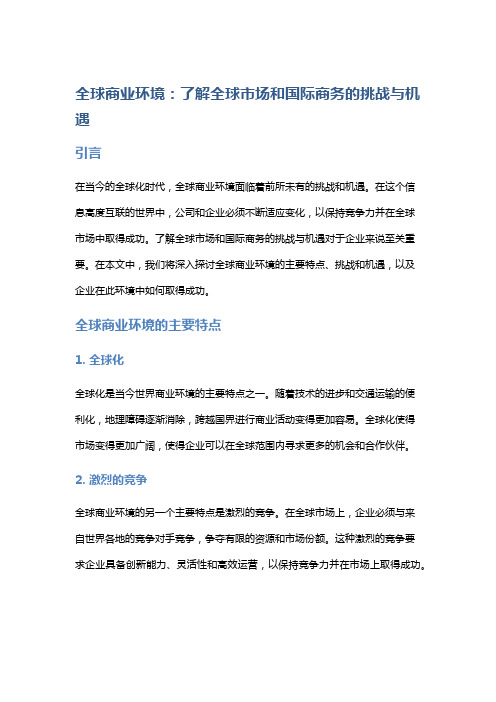
全球商业环境:了解全球市场和国际商务的挑战与机遇引言在当今的全球化时代,全球商业环境面临着前所未有的挑战和机遇。
在这个信息高度互联的世界中,公司和企业必须不断适应变化,以保持竞争力并在全球市场中取得成功。
了解全球市场和国际商务的挑战与机遇对于企业来说至关重要。
在本文中,我们将深入探讨全球商业环境的主要特点、挑战和机遇,以及企业在此环境中如何取得成功。
全球商业环境的主要特点1. 全球化全球化是当今世界商业环境的主要特点之一。
随着技术的进步和交通运输的便利化,地理障碍逐渐消除,跨越国界进行商业活动变得更加容易。
全球化使得市场变得更加广阔,使得企业可以在全球范围内寻求更多的机会和合作伙伴。
2. 激烈的竞争全球商业环境的另一个主要特点是激烈的竞争。
在全球市场上,企业必须与来自世界各地的竞争对手竞争,争夺有限的资源和市场份额。
这种激烈的竞争要求企业具备创新能力、灵活性和高效运营,以保持竞争力并在市场上取得成功。
3. 多样化的文化和法律制度由于全球商业环境跨越多个国家和地区,涉及到各种不同的文化和法律制度。
企业必须了解和尊重不同的文化价值观和商业风俗,并遵守不同国家和地区的法律法规。
适应不同文化和法律制度的能力将成为企业成功的关键。
4. 技术的发展技术的持续发展是全球商业环境的另一个重要特点。
随着信息技术的革新和互联网的普及,企业可以更轻松地与全球供应商、合作伙伴和客户进行沟通和合作。
技术的发展也加速了全球化进程,并为企业提供了许多新的机遇和挑战。
全球商业环境的挑战1. 贸易壁垒在全球商业环境中,贸易壁垒是企业面临的主要挑战之一。
国家和地区的贸易政策和法规可能对企业进入市场或出口产品产生限制和障碍。
贸易壁垒可能包括关税、进口限制、配额和技术壁垒等。
企业必须了解和应对不同国家和地区的贸易壁垒,以便在全球市场上取得竞争优势。
2. 文化差异不同的文化差异也是企业在全球商业环境中面临的挑战。
不同的文化背景可能导致语言障碍、沟通误解、商业习惯差异和交流问题。
全球化背景下的国际商务环境

全球化背景下的国际商务环境随着全球化的不断深入,国际商务环境也在大幅度的改变。
这种变化背后所涉及到的因素包括政治、经济、文化等各方面的因素。
尤其是在近年来,由于新冠疫情的爆发,国际贸易和全球经济都经历了一个非常动荡的时期。
本文将分析全球化背景下的国际商务环境,并讨论其中的一些重要因素。
一、全球化与国际商务全球化是一个复杂的现象,它几乎涉及到了各个角落的社会、经济和文化。
尤其是在21世纪以来,全球化趋势愈加明显。
全球化对于国际商务产生了重要的影响,它使得国际贸易得以更加方便、快捷和有效地进行。
同时,全球化还带来了更为激烈的竞争,这让企业需要更加努力地掌握国际贸易的规则和趋势。
国际商务环境中所涉及到的因素许多,它们都有着不同的影响。
在下面的内容中,我们将针对其中的一些关键因素展开讨论。
二、政治环境政治环境对国际商务环境具有着深远的影响。
由于各国之间存在着不同的政治制度,甚至存在着政治上的敌对关系,这就导致了在进行贸易时,存在着各种各样的政治风险。
例如,一些国家可能针对另一些国家的某些产品采取限制措施,或者对于某些企业进行抵制。
政治环境还包括政府的政策和诸如税收、财政支持、贸易协定等等。
一个国家的政策可以对于其他国家的商业活动产生重要的影响。
在一些情况下,政府还可能通过制定一些法规来限制外国的投资或者进行行业管制。
三、经济环境经济环境是国际商务环境中最重要的因素之一。
全球化使得经济活动变得更加国际化,这就使得全球经济更加相互依存。
经济环境中涉及到的因素包括市场、货币汇率、关税、海关和质量标准等等。
市场是企业进行贸易时最为关注的因素之一,市场对于企业的成功至关重要。
在进行市场分析时,企业需要考虑到各种因素,例如人口的数量、需求水平、生产水平、技术水平等等。
同时,在国际市场中还需要考虑到语言障碍、文化差异、法律和贸易协议等等因素。
货币汇率是影响企业进出口贸易的因素之一。
不同国家之间的货币汇率波动可能会导致企业在贸易过程中产生大量的风险。
- 1、下载文档前请自行甄别文档内容的完整性,平台不提供额外的编辑、内容补充、找答案等附加服务。
- 2、"仅部分预览"的文档,不可在线预览部分如存在完整性等问题,可反馈申请退款(可完整预览的文档不适用该条件!)。
- 3、如文档侵犯您的权益,请联系客服反馈,我们会尽快为您处理(人工客服工作时间:9:00-18:30)。
Five major functions of business activities:The innovation function is concerned with the development of new business ideas, in terms of products, processes, and methods of marketing, organization and management.The production function comprises those activities concerned with the creation of goods and services through the bringing together and mixing of a number of resource inputs, including materials, labour, finance, and plans.The marketing function deals with all those activities which relate directly to the consumer. These involve researching themarket and using that information in the development of the product, pricing, promoting, and ensuring that the product eventually reaches the consumer.The human resource management function is concerned with the planning, acquisition, development, utilization and reward of an organization's human resources. An important part of the role is the management of conflict through those activities associated with industrial relations.The finance and accounting function deals with the raising and management of funds, and the production of information to facilitate these two processesThe concept of interactionInteraction is a process which involves a two-way influence. It occurs when two elements are able toexert influences which bring about changes in each other.The concept of strategyA strategy comprises a set of objectives and methods of achieving those objectives.Global business environment model1.Social Factorsthe social responsibility aspects of modern business.the role of multinational corporations in business and especially ethical behavior.political issues relevant to business.environmental impact of business and the effects of theenvironmental change on business. pressure groups and their influences on policy.the issues surrounding animal rights, genetic engineering2.Legal FactorsThe laws relating to business and its employees of both China and the world - these will concentrate on health, safety, employment, anti-discrimination, labor relations, consumer protection and competition.3.Economic Factorswhat influences the level of economic activity;what stimulates economic growth;how interest rates are set and their influence on economic activity and trade;how public expenditure is financed and what it is spent on the various types of exchange rates in operation and how they influence international trade;trade flows between China and its major trading partners;inflation: its causes and consequences;the main causes of unemployment and how government tries to reduce it and its impact. 4.Political FactorsHow politics imposes both opportunities and constraints on business. This will involve an awareness of government intervention, micro and macro policies, such as inflation, employment, monetary, growth generators, fiscal, regional and competition policies.the international institutions that impact on business;how certain policies such as taxes impact on the world of work;the role of benefits in a democracy;how education and training can be encouraged;the role of trade unions in the new century;the impact of monetary policy on business confidence;the application of supply side policies and the business world.5.Technological PoliciesTheir impact on the business world.The impact will involve both opportunities and threats.Six steps in the case analysis process:Gaining familiarity with the case situation (critical case facts, persons, activities, context);Recognizing the symptoms (what are the things that are not as expected, or as they should be?)Identifying goals/objectivesConducting the analysisMaking the diagnosis (identifying problems, i.e., discrepancies between goals and performance, prioritizing problems etc.)Preparing the action plan (identifying feasible action alternatives, selecting a course of action, implementation planning, plan for monitoring implementationFive components of research design that are important for case studies:1) A study's questions2) Its propositions, if any3) Its unit(s) of analysis4) The logic linking the data to the propositions5) The criteria for interpreting the findingsHow managers scan their environment for information:1.The data about the companiese the case study approach with grounded theory3.Research design4.Conceptual framework: the categories and the model5.Strategic change6.The organizational context: Conditions affecting scanning7.Strategies for managing scanning8.Theoretical statements concerning the environmental scanning process。
